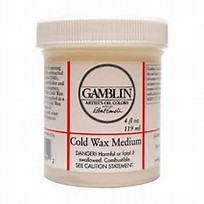Gamblin cold Wax as A Varnish

You may have seen my tutorial about how to properly vanishing a painting. Here is a link if you have missed it - http://www.nitpickyartist.com/varnishing-a-painting.html. Since creating that page, I've fallen out of favor of varnishing my paintings and have relied on oiling out to saturate any colors in the painting that had gone flat. In fact I haven't applied a clear coat of varnish to any painting since 2014. It was a part of the painting process I dreaded. I always felt a lot of pressure to get the varnish flat and even without leaving brush marks or letting dust settle in it. On top of that, I had a problem with modern synthetic varnish, such as Gamvar beading on the surface of my paintings; only damar varnish would level and adhere correctly.
After a poor varnish job in 2014, I decided it wasn't for me anymore. So since then, to finish a painting I will rub the thinnest layer of medium on to the surface of the painting where the color had dried flat and lost it's saturation. Although this process doesn't quite add the level of protection varnish does, it works just as well to make the painting look done. And unless a painting is to be hanged in a very dirty location, which I don't recommend, household dust is the usually the only physical contaminant it must endure. In my opinion oiling out a painting is an acceptable level on completeness.
However, to add the extra barrier between dust and my painting, I bought some of Gambin's Cold Wax Medium to use as a varnish. Their cold wax medium consists of beeswax, odorless mineral spirit (OMS), and a small amount of alkyd resin. It is also removable with OMS. Gamblin fully supports this wax application as an alternative protection method. A wax varnish to me makes a lot sense. All you need to apply it is a soft lint-free cloth such as a microfiber and if you ever need to fix a light scuff, you can just buff it out or add more wax depending on the severity. In addition to, it will never yellow or crack. The only downside is that you are limited to two finishes, matte and satin. Although I will say that I no longer prefer a high gloss finish. I mostly care about if the colors are fully saturated. Below is my first attempt at applying it to one of my paintings.
After a poor varnish job in 2014, I decided it wasn't for me anymore. So since then, to finish a painting I will rub the thinnest layer of medium on to the surface of the painting where the color had dried flat and lost it's saturation. Although this process doesn't quite add the level of protection varnish does, it works just as well to make the painting look done. And unless a painting is to be hanged in a very dirty location, which I don't recommend, household dust is the usually the only physical contaminant it must endure. In my opinion oiling out a painting is an acceptable level on completeness.
However, to add the extra barrier between dust and my painting, I bought some of Gambin's Cold Wax Medium to use as a varnish. Their cold wax medium consists of beeswax, odorless mineral spirit (OMS), and a small amount of alkyd resin. It is also removable with OMS. Gamblin fully supports this wax application as an alternative protection method. A wax varnish to me makes a lot sense. All you need to apply it is a soft lint-free cloth such as a microfiber and if you ever need to fix a light scuff, you can just buff it out or add more wax depending on the severity. In addition to, it will never yellow or crack. The only downside is that you are limited to two finishes, matte and satin. Although I will say that I no longer prefer a high gloss finish. I mostly care about if the colors are fully saturated. Below is my first attempt at applying it to one of my paintings.
|
|
|
|
I don't know if I will apply the wax to all my paintings, but it is a nice product to have on hand. Gamblin has their own tutorial where they recommend applying the wax in a circular motion. This may be okay for paintings on a textured canvas, but on a smooth panel, those swirls are visible in certain lighting situations. Since the wax doesn't level out, you are sort of left with light marks in direction you applied it in. For my painting, I decided to apply it in the direction in which most of my brush marks are in, top to bottom. I suppose if you wanted a perfectly flat and level wax application, you could thin it down with OMS and spray the wax with a spray gun and air compressor. But now we are complicating this simple wax application. For how easy this product is to use, I recommend it to anyone looking to add protection to a painting, but doesn't want to bother with a liquid varnish. I'll give it a 4.5 out of 5 stars.
|
|


